The science team at Glaxon is absolutely first rate. Thanks to the intellectual firepower behind Glaxon's R&D, this company is always pushing the boundaries of industry convention— in a good way. It's usually Glaxon, for example, that's pioneering ways to use some new ingredient that most other companies are afraid to gamble on. For Glaxon, though, it's never a gamble – this is a company that has the talent to make formulation decisions based on science and set the trends, rather than following them.
Glaxon isn't just bringing new ingredients to the supplement market, though. Every once in a while, they'll find an imaginative new use for a familiar ingredient that's been pigeonholed by more consensus-driven formulation approaches.
Reimagining a mainstay ingredient is precisely what Glaxon did with their rockstar pre-workout formula Specimen, which we covered on the PricePlow Blog back in March 2023. The ingredient in question? A designer preparation of D-Beta Hydroxybutyrate, known by its brand name goBHB.
What's interesting about this product is that D-Beta Hydroxybutyrate is an exogenous ketone, a type of supplement often seen in fat burners and nootropics, but rarely in a pre-workout role. Nevertheless, there's a sizable corpus of research literature discussing how ketones can support athletic performance, so it's very much to our benefit that Glaxon is helping push that to the fore with Specimen.
Let's get into the science (and the "why" below), but first check out our video on the topic and sign up for our Glaxon news alerts:
Glaxon Specimen Genesis – Deals and Price Drop Alerts
Get Price Alerts
No spam, no scams.
Disclosure: PricePlow relies on pricing from stores with which we have a business relationship. We work hard to keep pricing current, but you may find a better offer.
Posts are sponsored in part by the retailers and/or brands listed on this page.
This area is reserved for Team PricePlow's upcoming Research Study video.
Subscribe to our channel and sign up for notifications so you catch it when it goes live!
Metabolic Flexibility – Why It Matters
During exercise, your body burns a mixture of fat and carbs to fuel itself. One of the most important questions in exercise science, and one that has been hotly debated for decades, is which of these two fuels is better.
While there are pros and cons associated with each, one thing is certain: the more intense the effort, the more your body relies on carbs. This has been demonstrated many times, including in a 1993 study where athletically conditioned subjects were monitored during exercise at 25%, 65%, and 85% of their maximal oxygen consumption (VO2max). The researchers observed that the closer the intensity subjects' were to their VO2max, the more carbs they burned from stored glycogen.[1]
Unfortunately, the body's glycogen reserves are finite,[2] and the more glycogen you burn through, the harder it is to sustain high-intensity efforts. In other words, as glycogen stores are depleted, anaerobic capacity begins to drop.[3] This is why endurance runners are constantly consuming carbs during marathons – they want to preserve their top-end power for the entire duration of the race and strategically deploy it at decisive moments.

The next evolution of Glaxon's Specimen Series of pre-workouts is here, and it's a ketone powered version in the form of Specimen Genesis
Still, you don't need to be an ultramarathoner for glycogen depletion to be a concern. A recent research review showed that large glycogen reductions can occur during high-intensity efforts lasting just a few minutes.[4] Some compelling animal research, on the other hand, has demonstrated that increasing stored glycogen leads to a corresponding increase in exercise capacity.[5]
So, clearly, for anyone who wants to get the most out of his or her workouts, preserving stored glycogen should be of paramount importance. Even more so because glycogen doesn't only affect performance during a workout – it's also important for recovery from exercise.[6] This means that if you end up in a glycogen-depleted state, you could potentially be leaving fitness gains on the table.
And even if you're not that worried about optimizing performance or recovery, it's worth noting that the degree of fatigue an individual feels after exercise is strongly correlated with the amount of glycogen consumed during exercise.[7,8]
In other words, the more glycogen you have left after your workout, the less tired you'll feel. That's probably a big deal for most of our readers. We all have busy lives, and most of us tend to fit in exercise where we can. We don't want exercise to interfere with our other responsibilities, and extreme fatigue can definitely do that. Plus, being tired when you've got stuff to do is pretty miserable in itself.
So, in order to maximize performance, recovery, and enjoyment of exercise, we want to avoid burning carbs for fuel wherever possible. One option is to decrease exercise intensity— but it's better if we can burn fewer carbs at the same level of intensity. And the only way to do that is by burning something else.
That's where exogenous ketones come in.
Exogenous Ketones Spare Glycogen
Ketones, as most of us probably know, are the end product of ketogenic metabolism. The metabolic process of beta-oxidation, one of the human body's fat-burning pathways, produces ketone bodies[9] that can serve as an energy alternative to glucose for every cell in the body.
There are three types of ketone bodies:
- Beta-hydroxybutyrate (also known as BHB, the focus of our discussion today)
- Acetoacetate
- Acetone
Ketones are primarily synthesized in the liver,[10] and they're utilized as cellular energy during periods of food scarcity (or fasting), intense exercise depleting stored glycogen, and/or very low carbohydrate intake.[11-13] In a state known as ketosis, the fat converted into ketones through beta-oxidation can come from dietary fat or stored body fat.
There's just one potential problem with relying on ketones for fuel – in order for the body to make enough ketones to replace glucose, you have to enter ketosis, which requires carbohydrate restriction. In other words, to be in ketosis, you have to burn through all your stored glycogen by eating a ketogenic diet, which, as should be obvious in light of our discussion thus far, isn't ideal for athletic performance.
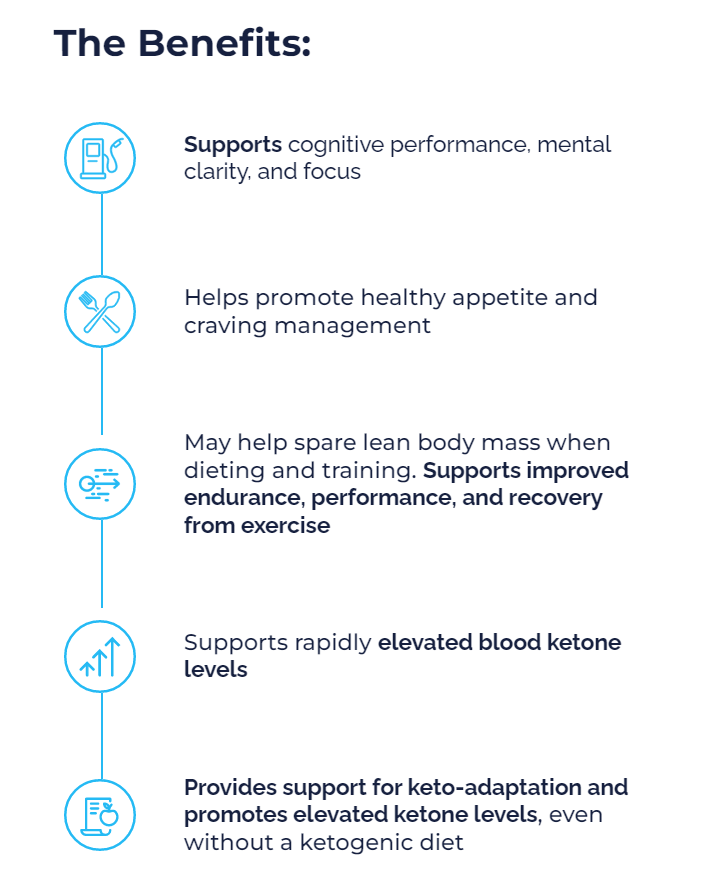
BHB Supplement Benefits, courtesy NNB Nutrition, a frequent Glaxon partner and novel ingredient manufacturer who makes the goBHB raw materials (see our article titled "Innovating BHB: NNB Nutrition and the Brains Behind Ketone Supplements")
But endogenous ketones produced via ketosis aren't the only option. Exogenous ketones can give us the ketone bodies we need to fuel exercise directly, while still allowing us to maintain our glycogen stores.
The best study we've seen on this subject was published in 2016, titled "Nutritional Ketosis Alters Fuel Preference and Thereby Endurance Performance in Athletes."[14]
This was a pretty complicated study – it actually consists of five different experiments. In one of (called "study #4" in the published paper), researchers gave seven male endurance athletes either a carbohydrate drink (CHO) or a mixture of carbohydrates and exogenous ketones (KE+CHO). The two drinks were matched in terms of taste and overall caloric content.[14]
The athletes then performed a cycling exercise test at 70% VO2max for 2 hours. Note that this is 70% VO2max, not 70% of max heart rate. That's a high level of intensity – working out this hard would definitely put most people's heart rate at greater than 70% of their max. And, as the authors of the study point out, this is ordinarily a highly glycotic level of intensity,[14] meaning that it's intense enough that the body normally relies on glucose for fuel. After an effort this intense, especially for such a long duration, you'd expect to see glycogen levels largely, if not entirely, depleted.
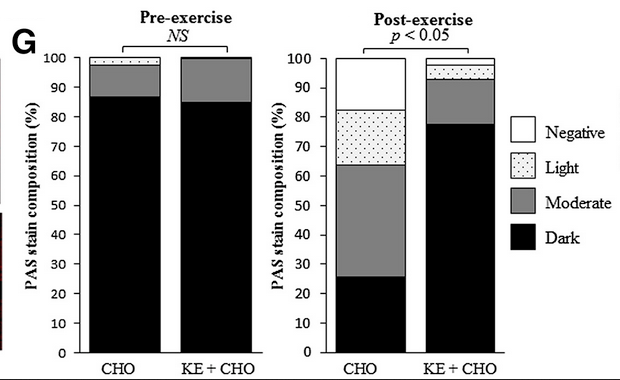
Endurance athletes who consumed a mixture of exogenous ketones and carbohydrates retained far more muscle glycogen after an intensive exercise test.[14]
Intramuscular glycogen is difficult to measure directly, so the researchers took before-and-after muscle biopsies from all the participants and then stained them under a microscope to check for glycogen content. The darker the samples, the more glycogen was present in the biopsied tissue.[14]
What they found was that athletes who consumed a mixture of carbs and ketones (KE+CHO) had far more muscle glycogen left at the end of the test. In fact, despite working at a high level of intensity for a very long duration, the KE+CHO group lost barely any of their muscle glycogen at all.[14]
You might expect this to compromise performance but, remember, performance was controlled – and individualized! Each study participant was working at 70% of his own individual VO2max for the entire 2 hour duration of the exercise test.[14] By definition, there couldn't be a drop in performance under this study design.
If that's not convincing enough for you, then know that the authors of this study did another experiment (called "study #5" in the published paper) specifically designed to ascertain whether burning a mixture of ketones and carbs could reduce performance. They found that there was no decrease in performance.[14]
In fact, the opposite occurred. Here's a direct quote from the study discussion:
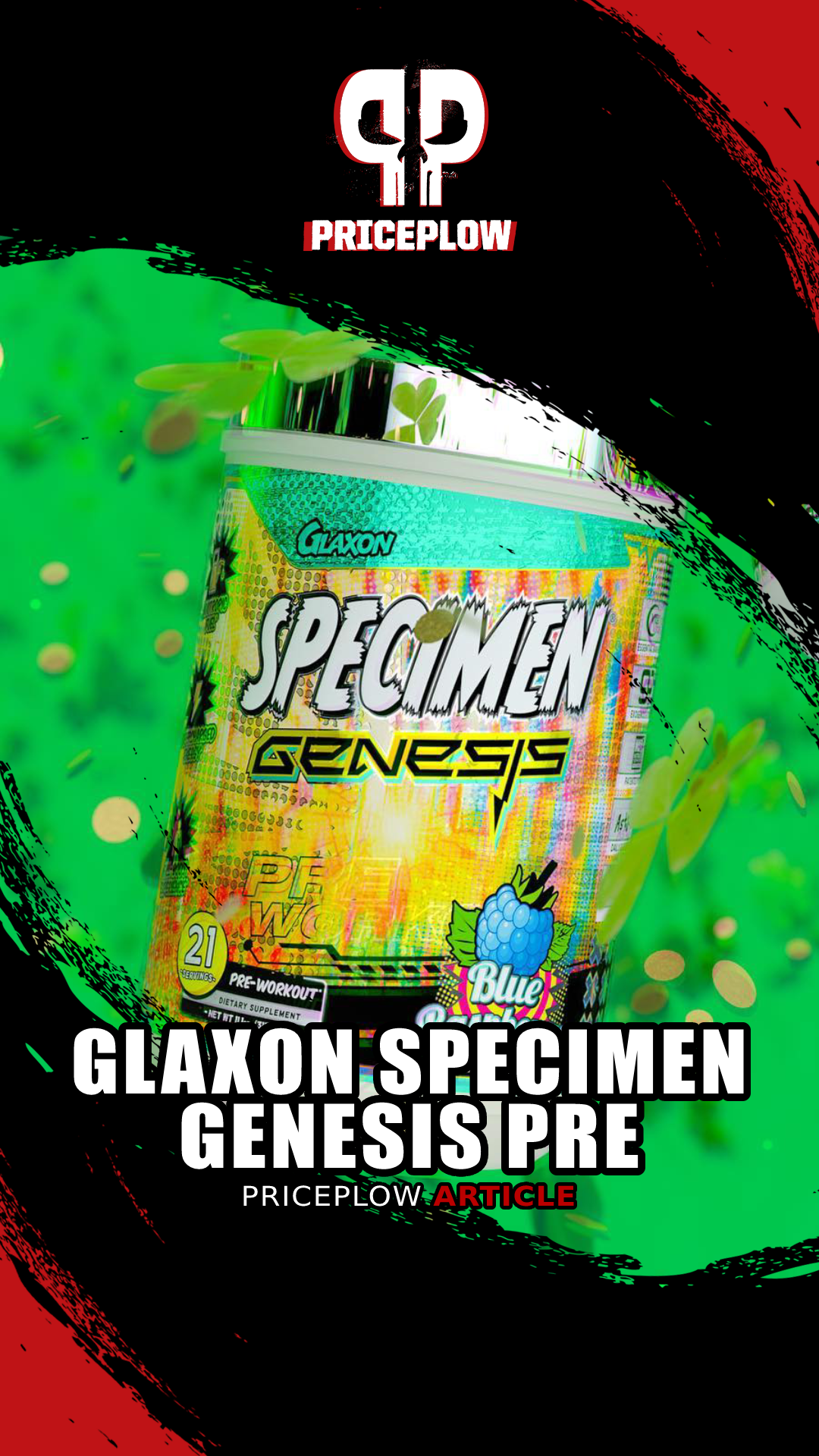
We highly recommend trying Glaxon's Specimen Genesis pre-workout to feel the energy and performance benefits the unique addition of ketones.
"Time trial performance following 1 hr of high-intensity exercise was significantly improved in KE+CHO versus CHO conditions. Athletes cycled on average 411 ± 162 m further (p < 0.05) over 30 min on KE+CHO versus CHO equating to a mean performance improvement of 2%"[14]
The authors also point out that exogenous ketones offer a unique metabolic advantage for athletes that can't replicated:
"Here we show how a nutritional source of ketone bodies alters conventional muscle fuel metabolism and physical performance, alone and in combination with nutritional CHOs. This physiological state operates in contrast to that of endogenous ketosis, where replete glucose reserves, an intact insulin axis, and elevated ketone bodies would never usually coexist."[14]
Conclusion
Because exogenous ketones are burned preferentially during exercise, supplementation with them can support exercise performance, recovery, and enjoyment. Far from decreasing performance, exogenous ketones can actually improve it.
Needless to say, it makes total sense to put them in a pre-workout formula. Will this be the next big industry trend? It's very possible – and as is usually the case, it'll be Glaxon leading the way.
To learn more about the rest of this pre-workout, head back to our main Glaxon Specimen Genesis article.
Glaxon Specimen Genesis – Deals and Price Drop Alerts
Get Price Alerts
No spam, no scams.
Disclosure: PricePlow relies on pricing from stores with which we have a business relationship. We work hard to keep pricing current, but you may find a better offer.
Posts are sponsored in part by the retailers and/or brands listed on this page.
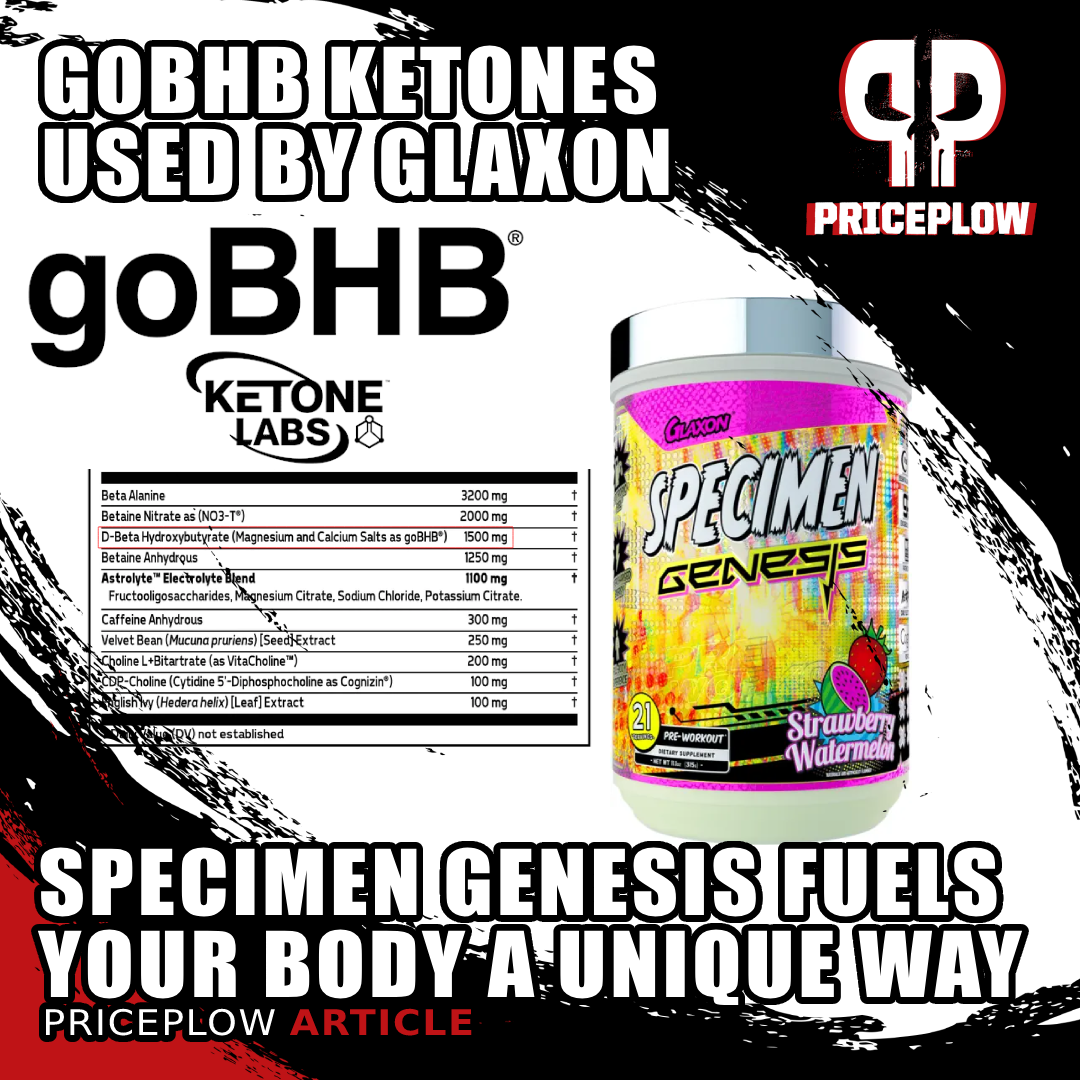
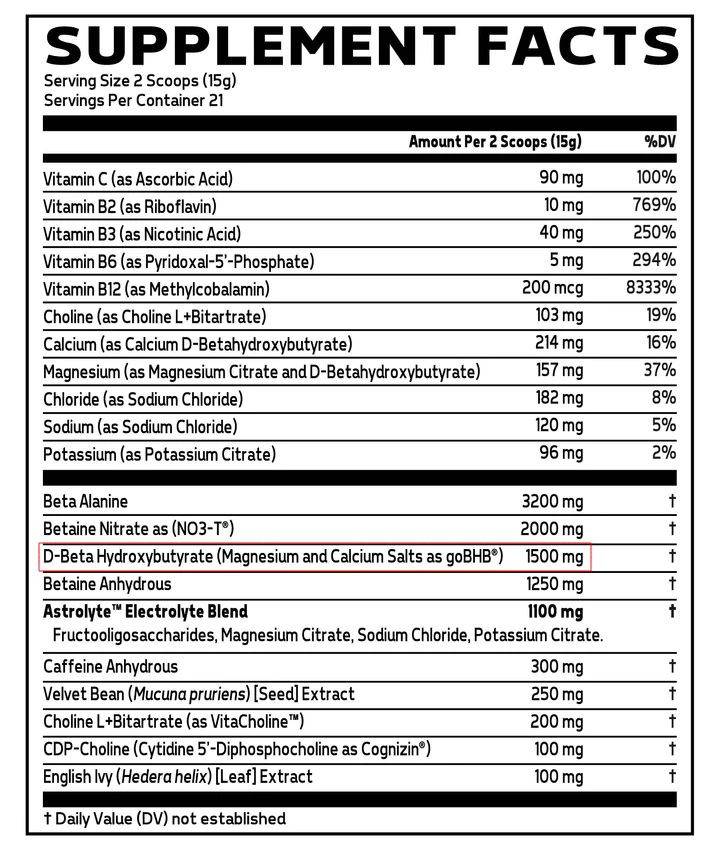


Comments and Discussion (Powered by the PricePlow Forum)